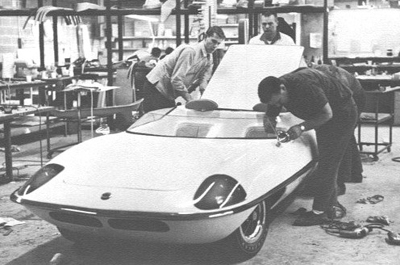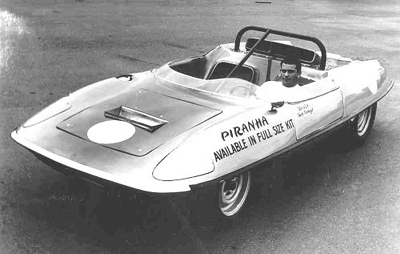The Piranha
I donŌĆÖt know where car companies come up with the names for their models. What's a Sephia? A Camry? Heck, for that matter, what's a Camaro, other than one of the most famous car names ever?
In┬Āthe mid- to late 1960s, animal names were the hot ticket for car makers ŌĆō Mustang, Beetle, Bronco, Cougar, Cobra, Road Runner, Impala, etc. ŌĆō and even our aquatic friends were included. There's the famed Plymouth Barracuda, the Corvette Stingray, the rare AMC Marlin (one of which my stepfather owned) and, of course, the Piranha.
Everyone's heard of a piranha, right? The flesh-devouring curse of the Amazon River? A pack of the razor-fanged fishes is said to be able to strip a cow carcass to bones in minutes. To veteran drag race fans of the 1960s, the name evokes one of the wildest machines to traverse the quarter-mile, the AMT Piranha, and I present its story here as part of our wedge discussion because, well, it was kinda wedge shaped.
Although a lot of fans have heard of the AMT Piranha, not a lot realize that it had its roots as a street car. Yeah, go figure. Most people ŌĆō yours truly included ŌĆō think of it as a pure racing design, but it was in fact a marketing tool designed to showcase a limited-edition sports coupe being built by the AMT company, known to drag race model builders all over the globe for its long and varied line of 1/24th-scale drag cars.
Now, anyone who knows anything about 1960s automobiles knows that, if nothing else, they were heavy metal. Yet during the early 1960s, Marbon Chemical, a division of Borg-Warner, wanted to promote the expanded use of plastic, especially in automobiles. Remember that back then, even our soda bottles were made of real glass, not plastic, and plastic had a pretty small line of accomplishments.
 The first CRV prototype, under construction |
 The Piranha SCCA sports car racer |
Rather than try to weasel its way into the production line of the Big Four's cars ŌĆō though Pontiac did use the material in the grilles of some of its '66 models -- the company decided to build its own car entirely of plastic (save for the running gear, of course), using a proprietary material called Cycolac, which to that point was being largely used in telephones. The company┬Āhired race car engineer Dann Deaver of Centaur Engineering to design a two-seater roadster with a rear-mounted Corvair engine. The car was built around one of Centaur's tubular race car frames and made its first public appearance at an SAE convention in Detroit in early 1965 under the acronym CRV, which stood for Cycolac Research Vehicle.
People loved the prototype, so Marbon commissioned Centaur to build a second one and decided that it should undergo its durability testing in motorsports, specifically on the SCCA circuit. The CRV-II exceeded all expectations and, with veteran driver Dick Carbijal at the wheel, even won its class that year, and its tough body even survived a wreck. After CRV-III was built and destroyed in mandated crash testing, the CRV-IV and V were built in early 1966 and included a coupe roof with gullwing doors. Both were sent overseas to promote the use of plastic at Marbon's foreign production facilities.
But Marbon never wanted to be a car manufacturer; it just wanted to sell plastic to someone who believed in the idea. Enter AMT Corp., whose thing definitely was plastic cars, albeit on a much smaller scale.
 Car builder Fred Smith and the Piranha |
 The car made impressive shakedown runs at Irwindale Raceway. |
 |
 |
 |
 |
 |
AMT purchased the rights from Marbon to build the plastic car and bought its inventory of plastic bodies and fiberglass chassis. It hired noted California customizer Gene Winfield ŌĆō who had been in the fold since 1962 helping design model cars -- to lead a team to design and build plastic sports cars at its new Speed & Custom Division, gave the car a new name -- the Piranha --and decided to promote the venture on the dragstrip.
Fred Smith, a former employee of none other than Don Garlits, was just 24 when he designed and built the chassis, which was wrapped in a body made of two pieces of vacuum-formed 3/16-inch Cycolac. An opening was cut in the nose to duct air through the body and over the cowl to keep the nose down. The car was painted a lemon gold color that blended to bronze farther down its flanks. Despite its dragster-like shape, the car was actually built to compete in Funny Car.
According to specs on a Piranha website, the bare chromoly frame was rigid to improve handling yet said to weigh just 68 pounds and featured a tubular front axle suspended by a transverse torsion bar. The Piranha had a 120-inch wheelbase, was 148 inches from snout to tail, and stood less than 40 inches high. Thanks to extensive use of aluminum and magnesium where plastic was not practical (mounts, pedals, fuel tank, etc.), the car weighed just 1,550 pounds race-ready.
Future Top Gas star Walt Stevens and wrench Joe Anahory, of Dead End Kids fame, got the call to campaign the wild machine. Anahory built a .030-over 392 Chrysler that was installed, mounted at eight degrees down ŌĆō again to improve handling ŌĆō topped by a 6-71 blower, and mated to a Schiefer dual-disc clutch and connected to a 1960 Olds rear end through a special Donovan coupler that allowed the engine to be as close to the rear end as possible.
In its debut at Southern California's Irwindale Raceway, Stevens shoed the car to an 8.81 at 182.64 mph, a speed that was claimed as "the fastest for any full-bodied vehicle," though one could argue the "full-bodied" part.
The team ran a full match race schedule, with multiple dates each week from May through September, and commanded top dollar to match race local stars or just make exhibition passes. And whatŌĆÖs not to like? The car made low-eight-second passes, smoking the tires past half-track, dragster-style. Despite its fleetness, the car handled superbly, thanks to all of the advance planning. ŌĆ£It drove like a Cadillac,ŌĆØ said Stevens. ŌĆ£I never had any problems at all.ŌĆØ
The car regularly ran 8.20s and 8.30s and speeds approaching 190 mph, with a reported best legitimate performance of 8.08 at 193 mph.
Shortly after the car hit the dragstrips, AMT released a 1/25th-scale version of the Piranha, kit No. 910. Winfield, who also had designed cars for the entertainment industry, used his contacts to get the Piranha big-time exposure on the TV series The Man from U.N.C.L.E. According to one report, "the original U.N.C.L.E. car was to be based on a Dodge Charger, but the network had second thoughts about giving them too much free advertising or perhaps cancelling their multimillion-dollar advertising campaign" and decided that a completely new car needed to be used. The car only appeared on a handful of shows in 1967.
In October 1966, after the contract with Stevens and Anahory ended, AMT briefly gave the car to Don Cook and Connie Swingle for an attempt at the first Funny Car run to exceed 200 mph. Although there were reports of a 200-mph pass, according to a story by Dave Wallace Jr., "Stevens remembers Swingle hitting 197 at Lions and believes that to be the carŌĆÖs top speed ever."
AMT sold the Piranha, and it eventually ended up in the huge Harrah Collection in Reno, Nev., where it was stored for many years before being auctioned in 1986 for $6,500. The car was listed in the auction catalog thusly: "Poor overall condition ... not in running condition ... missing parts."
The car subsequently was resold for $8,000 in 1990 to Rich Riddell ŌĆō Riddell beat out another interested bidder in Garlits, who had┬Āhoped to add it to his impressive Museum of Drag Racing -- who immediately began restoring the car but reportedly lost interest in the project for several years. He worked on it from 2001 until his death in November 2008. Riddell's widow put the car up┬Āfor sale early the next year, and Garlits was finally able to acquire the car, which should be either finished or nearly finished.
Another great save by "Big Daddy."

What's a Camaro?
Back to my original point, I think this is interesting info regarding the Camaro from a Camaro history site. While Chevy labored on the car, its answer to Ford's extremely popular Mustang, "the car had been called┬Ā various names by GM and the press, including Nova, Panther, Chaparral,┬Āand Wildcat (later used by Buick). It is rumored that Chevy also considered using the letters 'GM' in the name and came up with G-Mini, which evolved into GeMini and finally Gemini. General Motors Headquarters supposedly killed that name because they didn't want the letters 'GM' used in case the car was a failure. Finally, the car was introduced to the press as the Camaro, considered to be a good name because┬Ānobody knew what it meant. Chevrolet produced an old French dictionary showing that the word meant 'friend' or 'companion,' but Ford found an alternate meaning in an┬Āold Spanish dictionary: "a small,┬Āshrimp-like creature.' The automotive press had a good┬Ālaugh over that and an even bigger┬Āone when one journalist found yet another meaning: 'loose bowels.' "
Oh, those wacky journalists. You just canŌĆÖt trust us to keep a straight face.
OK, that's the story of the Piranha (and some bonus Camaro trivia). Interesting stuff. Thanks for reading.




















































